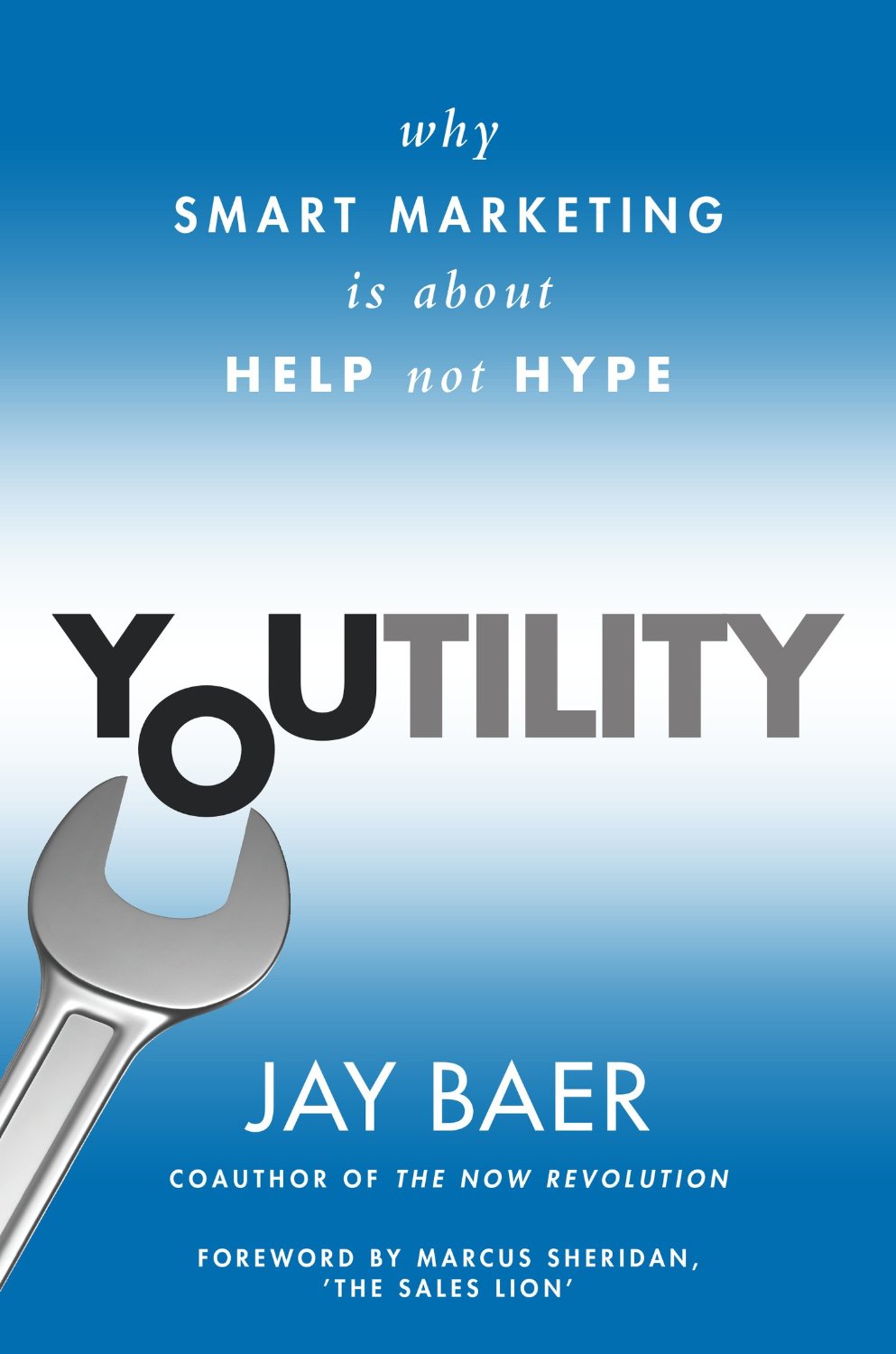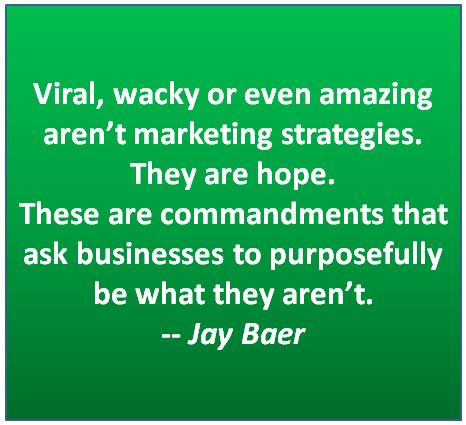By Mark Schaefer
If you’re a regular reader of {grow} you’ll know that I’m a big fan of Jay Baer. I think he is one of the great minds and entrepreneurs in this marketing space. So I was really excited to get an advance copy of his new book, Youtility: Why Smart Marketing Is about Help Not Hype.
Youtility is packed with data and examples that set forth an unsettling new path for content marketing in the digital age. It synthesizes the technological forces of the web, the psychological needs of consumers, and the common sense that can only come from Jay’s extensive experience to create a formidable new idea.
Instead of summarizing the book, which really would be a disservice to you because you MUST READ this book, I thought it would be much more interesting to explore a little of the back story of the subject matter with first-hand insights from the author. Here is an interview with Jay Baer and the creation of “Youtility:”
Mark: One of the interesting things about this book is that you actually discredit an idea from your first book. I thought this was bold and honest. Instead of “be amazing,” you now counsel “be useful,” which I think is a lot more accessible. Was there one conversation or event that crystallized this concept for you? An “a-ha” moment that led to the framework for this new book?
Jay: Certainly, The NOW Revolution isn’t wholly (or even significantly) about being amazing, but certainly we advised in that book that being incredibly responsive and human can be a success formula for business. And I still love it when companies commit to massively exceeding customer expectations. After all, the praise you earn online almost always comes from real actions offline.
 But, customer experience as the fulcrum for “amazing” is one thing. Trying to make “amazing” marketing is quite another, and that’s where the disconnect occurs. For me, the tipping point was Old Spice. The success of that campaign, and the corresponding media coverage, drove a shift in marketers’ thinking that spawned 10,000 “get me one of those viral videos” meetings.
But, customer experience as the fulcrum for “amazing” is one thing. Trying to make “amazing” marketing is quite another, and that’s where the disconnect occurs. For me, the tipping point was Old Spice. The success of that campaign, and the corresponding media coverage, drove a shift in marketers’ thinking that spawned 10,000 “get me one of those viral videos” meetings.
“Viral,” “wacky” or even “amazing” aren’t marketing strategies, they are hope. They are commandments that ask businesses to purposefully be what they aren’t, in an attempt to catch lightning in a bottle. Lots of consultants are making a living these days telling companies that the best way to succeed in marketing is to just be a better business. That’s a circular argument, at best.
So, I created Youtilty as the rational counter-balance.
Simultaneously, we have the meteoric rise of content marketing as a marketing imperative. There are great books that offer outstanding how-tos for content, but in the conversations I have with large corporate clients, what seemed to be missing was the “why” and the proof that it works.
Youtility is a strategic framework for content marketing, and it’s a broad enough framework to also apply beyond content. In fact, several people who have read early copies feel Youtility works very nicely on the personal level. I didn’t write it that way, but am delighted if people can apply Youtility lessons to their real lives, not just their business lives.
The book is filled with fascinating and original case studies. But it occurred to me that ultimately, there are also probably limits to how useful companies can be, too. For example, Columbia Sportswear created an app to help people find tie knots. Once you find a way to help a customer at a point of need, then what?
Youtility is about marketing sideways, instead of head-on. Columbia doesn’t sell rope, but their prospective customers often need knot-tying help. That gives them a new relationship foothold with those customers that transcends the transactional. The fact that they gave away useful information without the expectation of immediate return will drive awareness, loyalty, and advocacy long-term among the consumers of that information. Among all of them? No. But among some of them? Absolutely, and you only need to look at the success of Marcus Sheridan’s River Pools to see the dollars hidden inside being useful.
 One of the things you say in the book that is profound, maybe even shocking at first, is that we’ve always tried to build loyalty with people, and we can no longer rely on that. Now, we must build loyalty with information. That’s going to be a disorienting concept for a lot of people. Can you explain this idea?
One of the things you say in the book that is profound, maybe even shocking at first, is that we’ve always tried to build loyalty with people, and we can no longer rely on that. Now, we must build loyalty with information. That’s going to be a disorienting concept for a lot of people. Can you explain this idea?
Yes, for old dudes like us, it goes against everything we’ve been taught. But, it’s very much the case. Customers of all types increasingly have access to high speed Internet access at all times. Thus, they have the means to research everything, and they do. Research from Google and elsewhere show a sharp rise in the number of information sources consumers need before making a purchase. And why not? Why wouldn’t you do some research before buying, when there is almost no hassle involved in doing so?
Both you and I keynoted a big conference of automobile dealers a few weeks ago. Talk about an industry that is living through this “relationships created by information” lesson! Routinely, they told me, buyers come into the dealership knowing more about the vehicles than the salespeople. At that point, the role of the salesperson shifts entirely. And this will happen to most industries, eventually, as information is set free.
Concurrently, the extreme (although perhaps self-imposed) time pressures this always-on world has created makes consumers far less interested in synchronous exchanges.
If you and I talk on the phone (which we rarely do) we have to coordinate schedules. If we email, text, DM, Facebook message, Linkedin message, etc. we can communicate asynchronously, on our own schedules. Every person reading this has purposefully NOT filled out a contact us form on a site, even though they were interested, because they didn’t want to be contacted by a salesperson. Instead, they chose to kick the informational tires themselves, and only when they are WAY down the purchase funnel do they reach out for human contact.
Another key idea I loved in the book is that “industry doesn’t matter.” Consumer expectations are being set by whatever content, apps and brands they love. Are we at a point where there is a blurring line between B2B and B2C marketing?
Yes! I’ve been preaching this for a long time. It doesn’t matter what your competitors are doing, it matters what the bellwether sites and companies are doing. B2B buyers are also B2C buyers, of course. Thus, their expectations are manifestly influenced by what the big B2C players are doing. If you think Zappos’ norms have no impact on what SAP is doing, you’re missing the big picture.
B2B and B2C marketing mechanics are fundamentally the same. The only differences are at the execution layer.
You obviously did a tremendous amount of research and interviews for the book. I can imagine you had weeks of almost total immersion in the subject. How are you personally different after this intense experience?
I wish. I researched and wrote the book almost entirely on nights and weekends, as the consulting side of Convince & Convert could not halt (or even slow down) to create the book. But, I had some help! Kim Corak, who heads special projects at C&C, organized and executed a lot of the interviews in the book, thankfully. Both she and I used Speechpad.com to create text transcripts of all the interview calls, which was a big time-saver. Also, the book of Youtility is loosely based on the keynote presentation of Youtility, so that made the narrative structure of the book a little easier to get. Overall, the writing took about 10 weeks.
I am personally different in that I feel significantly better about creating books. I know now that I can do it myself (I wrote The NOW Revolution with Amber Naslund), and I know now I can do it with a fair degree of efficiency (other than the need to essentially ignore my family on nights and weekends for a couple months).
The marketing of the book is still a ton of work, and I’ll need a break after launching this one, but I hope I have many more books to come.
Here’s a free chapter of Jay’s book for {grow} readers!
Disclosure: I received this book for free. Book links are affiliate links.



